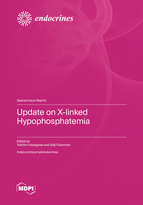Update on X-linked Hypophosphatemia
A special issue of Endocrines (ISSN 2673-396X). This special issue belongs to the section "Pediatric Endocrinology and Growth Disorders".
Deadline for manuscript submissions: closed (20 May 2022) | Viewed by 30540
Special Issue Editors
Interests: pediatric endocrinology; sex differentiation; growth; adrenal and gonad; bone and Ca/phosphate metabolism
Special Issues, Collections and Topics in MDPI journals
Special Issue Information
Dear Colleagues,
X-linked hypophosphatemic rickets/osteomalacia is a clinical disease having seen great advancements, the key milestones being (1) the positional cloning of PHEX as a result of X-linked hypophosphatemic rickets/osteomalacia (1995), (2) the discovery of FGF23, a key molecule for phosphate regulation and the understanding of rickets/osteomalacia (2000 and 2001), and (3) the clinical application of the anti-FG23 antibody treatment (2018).
Rickets/osteomalacia is usually classified into two groups, (1) vitamin D-related and (2) hypophosphatemia-related, the latter further divided into (2-1) FGF23-related (e.g., XLH) and (2-2) defects in the renal tubules (e.g., Fanconi syndrome). This time, we would like to focus on hypophosphatemic rickets/osteomalacia, particularly on XLH, starting with a couple of general expert review articles, followed by ones on other specific items (related to XLH), such as the pathophysiology of XLH and the anti-FGF23 antibody treatment. The editors have considered balancing between basic and clinical medicine as planned below, hoping for the Special Issue regarding this field to be useful not only for learning in general, but also thinking (out of the box), having commenced asking experts to contribute. In addition, the editors would really like to invite physicians, hopefully challenging themselves to write new original articles, commentary/hypotheses, case reports on hypophosphatemic rickets/osteomalacia and related areas.
(1) General reviews
- Bone mineralization;
- Regulation of serum calcium and phosphate levels;
- Pathology/clinical cause of rickets/osteomalacia.
(2) Specified reviews
- XLH in children (Dx, Px, Tx);
- XLH in adults;
- Anti-FGF23 treatment in children;
- Anti-FGF23 treatment in adults.
(3) Others
- Commentary/hypothesis;
- Original articles;
- Case presentations;
- Review articles (on issues other than described above).
Prof. Dr. Yukihiro Hasegawa
Prof. Dr. Seiji Fukumoto
Guest Editors
Manuscript Submission Information
Manuscripts should be submitted online at www.mdpi.com by registering and logging in to this website. Once you are registered, click here to go to the submission form. Manuscripts can be submitted until the deadline. All submissions that pass pre-check are peer-reviewed. Accepted papers will be published continuously in the journal (as soon as accepted) and will be listed together on the special issue website. Research articles, review articles as well as short communications are invited. For planned papers, a title and short abstract (about 100 words) can be sent to the Editorial Office for announcement on this website.
Submitted manuscripts should not have been published previously, nor be under consideration for publication elsewhere (except conference proceedings papers). All manuscripts are thoroughly refereed through a single-blind peer-review process. A guide for authors and other relevant information for submission of manuscripts is available on the Instructions for Authors page. Endocrines is an international peer-reviewed open access quarterly journal published by MDPI.
Please visit the Instructions for Authors page before submitting a manuscript. The Article Processing Charge (APC) for publication in this open access journal is 1000 CHF (Swiss Francs). Submitted papers should be well formatted and use good English. Authors may use MDPI's English editing service prior to publication or during author revisions.
Keywords
- X-linked hypophosphatemic rickets/osteomalacia
- FGF23
- bone mineralization





